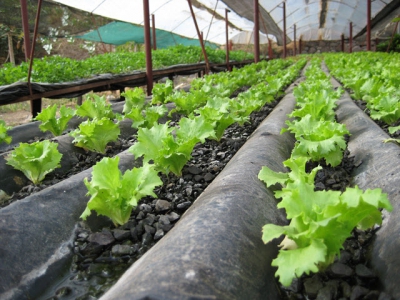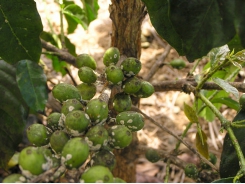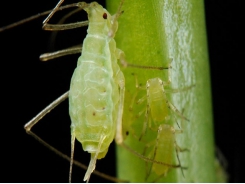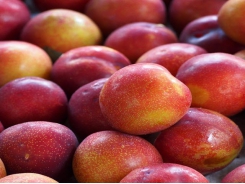Growing Lettuce in Greenhouses and Frames

The lettuce Lactuca sativa is increasing in importance as a greenhouse crop since the breeding of short-day varieties has made year-round production possible. The quality of greenhouse lettuce, furthermore, is better than that of lettuce grown out of doors and it needs only relatively cool conditions for cultivation.
Lettuce thrives in a fairly rich soil, pH 6-6.5, of fairly high nutritional status—potash and phosphate index 4 and medium nitrogen levels. It is particularly susceptible to high salt concentration and grows best in a moist regime. Lettuce culture in a greenhouse is almost entirely confined to growing in borders, although on an amateur scale pots may be used. The culture of lettuce on capillary matting (NFT) has recently been developed. It requires relatively high light intensity, and light levels during the winter months in many areas are too low for entirely successful year-round growing.
Seed sowing procedure
For many years it was the practice to sow lettuce in standard seed trays at the rate of 300-500 per tray in either John Innes or a soilless seed compost (low nutrient for winter, high nutrient for spring/summer), but there is now much interest in individual sowing of pelleted or split pill seed in soil or peat blocks, the block making and sowing being carried out mechanically on a large scale. Small peat pots can also be used to good advantage for space sowing. Alternatively seed can be sown direct in greenhouse borders or frames. There are approx 500-600 lettuce seeds per gm and the germination percentage is usually fairly high; 10/64-12/64 grading pelleted seed contains approximately 13,200 per kg (6,000 per lb.) Pellets and split pills are now generally sold by number not weight.
When sowing seed fill boxes (or pots), strike off level, then firm up with a board. Scatter seed on thinly and cover lightly before firming in. Water with a fine rose and place seed either in a germinating cabinet or cover with black polythene. Pelleted or pilled seed should be sown individually in the selected container, watered in, and covered with polythene. These germinate more evenly in high humidity with plenty of air and moisture, germination frequently being delayed by covering the seed too deeply. There is increased interest in space sowing pelleted seed directly into borders, singly or doubly at 23 x 23cm (8 x 8in) intervals, or at 10 x 10cm (4 x 4in), thinning out. Firm and thorough preparation is essential.
Germination occurs under a wide range of temperatures, although 13-16°C (5560°F) is the optimum and too high temperatures will depress germination. Polystyrene sheets are useful. Good light levels must be given to seedlings as soon as they germinate, otherwise they become etiolated and drawn.
To avoid damage to roots prick off before too large, either directly into prepared borders or into small peat pots or peat blocks when direct sowing into these is not practised in the first case. The soil for peat or paper pots should be of John Innes Potting No 1 nutrient level, and the same is true of peat or soil block composts.
The use of growing rooms
The use of growing rooms in the raising of plants considerably shortens the propagating period, and is increasingly practised. Seed is sown normally and germinated either in a germinating cabinet or a warm greenhouse in stacked boxes. As soon as the seedlings have germinated they are placed under lights at and given continuous 24 hour light at a temperature of 20°C (68°F) for 3 days, before being pricked off into blocks and given continuous 24 hour light for 8 days 6000 lux. They are watered and fed regularly when in the growing room and develop very rapidly, being ready for planting 3 weeks after sowing. Alternatively 15,000 lux/lumens can be given on a double batch system (12 hour lighting in each 24 hours) for 8-10 days more or less according to development.
Space sowing techniques are also readily adaptable to growing room conditions. It is difficult to quote exact techniques for growing rooms as they tend to be the subject of frequent modification, but the basic principle is quite clear; to raise plants on a programmed basis (and a planned cropping scheme) irrespective of weather conditions, utilizing ‘waste heat’ from the lights to warm the growing room or whatever other erection is being used. Carbon dioxide enrichment is beneficial in growing rooms at 2-3 fold rate (600-900 or 1,000 ppm).
Preparation of borders
Greenhouse borders should be analysed to check the nutrient level with particular reference to the pH figure, the greenhouse thoroughly washed down and consideration given to whether sterilization in any of its forms is necessary. Lettuce, while prone to certain fungal maladies, does not make a soil “sick”, particularly if grown as a single crop and then followed by tomatoes. For successive cropping, however, some sterilization would inevitably be needed, there being much use made of the sheet steaming technique in commercial circles. Chemical sterilization in one or other of its forms will also be effective since, apart from the incidence of fungal disease, weeds can be very troublesome with this closely grown crop, chickweed being a particular menace, although chlorpropham mixtures have been used with some success in this instance under glass (commercially only!).
Lettuces are frequently grown before a tomato crop and therefore the soil treatment is complementary to both crops. If clean FYM is available this should be dug in at 50kg/8m2 (1cwt per 8 — 9 sq yd), care being taken that the FYM does not introduce weeds (alternatively sterilize the soil thereafter, flooding after heat sterilization to reduce the salt content to around pC index 2). Base feeds in the order of 34-68g/ m2 (1-2oz per sq yd) of hoof and horn meal and 130-170g/m2 (4-5oz per sq yd) of a medium potash fertilizer are general, although when soil is found on analysis to be well supplied with phosphate and potash (index 4), apply only the hoof and horn meal, particularly if FYM has also been applied.
Borders should be well forked, firmed, and raked to a reasonable tilth, being of a moisture content where the surface only dries out after a few days but plenty of moisture is available at lower depths. If this is not the case, borders will require a light watering or alternatively the plants should be well watered in after planting.
As a preventative against root rot, quintozene dust (commercially available only) is applied evenly a day or two before planting, being raked well into the surface.
Planting
The soil should be warmed to 10-11°C (50-52°F), which may mean turning the heating on a week or so before planting in the winter months. Spacing is important for hearting and health; 20 x 20cm (8 x 8in) square or staggered is general, give or take a little for size and growing habit of varieties. Use a dibber when planting from a seed box, checking for brown discoloration indicative of disease. Plants in peat pots or blocks should be planted with a trowel, or on a larger scale by a mechanical planter which indents the soil. Water the plants in lightly with a fine rose on a hose-pipe, or spray-lines.
Temperature patterns
Lettuces respond to low night (7-9°C/ 45-48°F, or lower) and slightly higher day temperatures of 13-16°C (55-60°F), especially when carbon dioxide enrichment is being carried out — approximately 63-68 kg (140-150lb) CO2 per 93m2 (1,000sq ft) being required for the winter crop from half an hour after sunrise to one and a half hours before sunset for approximately 4-5 weeks. Continuous daytime carbon dioxide enrichment is only feasible during the lower temperature winter months when no ventilation is necessary, and day temperatures tend to reach 18°C (65°F).
Some of the hardier varieties will tolerate reasonably low temperatures. The rule should be to select a variety suitable for the likely environment, or else to adhere to the temperature recommendations for a particular variety.
Light intensity is also an important factor to bear in mind: the net effect of too high a temperature under poor light being non-hearting, apart from physiological troubles such as tip burn of the leaves and botrytis.
Watering and ventilation
Better lettuce is produced in high moisture regimes. Where soil is of a retentive nature and water tables high, it may be unnecessary to water lettuce at all, but in general watering commences when the lettuces have a leaf spread of 5-8cm (2-3in), an average application overall being about 27 litres per m2 (5 gallons per square yard). Too heavy dampings or overhead sprayings should be avoided as this encourages fungal diseases. Two dustings of Benomyl (Benlate) or other fungicide are generally given during the season, especially in dull, wet areas with a high risk of botrytis during the winter months.
Ventilation is important in preventing excessively high day temperatures, particularly following upon a relatively cold night. Rapid fluctuation of temperature causes tip burn. Ventilation should be given at the 18°C (65°F) level.
Harvesting
Lettuces are cut when they have achieved a reasonable size. This varies from 13 weeks down to 6 weeks for the later spring crop. Using growing rooms shortens the period. Begin cutting early to prevent wastage.
Varieties
Basically there are two main types, the tight hearted and the bigger, crisp type. Red leaved lettuce are very popular now. Select varieties suitable to environment and time of year, ie short day lettuces for the dull winter months, and note resistances offered in the catalogues with reference to local conditions.
Related news
Tools

Phối trộn thức ăn chăn nuôi

Pha dung dịch thủy canh

Định mức cho tôm ăn

Phối trộn phân bón NPK

Xác định tỷ lệ tôm sống

Chuyển đổi đơn vị phân bón

Xác định công suất sục khí

Chuyển đổi đơn vị tôm

Tính diện tích nhà kính

Tính thể tích ao




 Other tomato wilts
Other tomato wilts  Pests and Diseases of Tree Fruit - Part…
Pests and Diseases of Tree Fruit - Part…